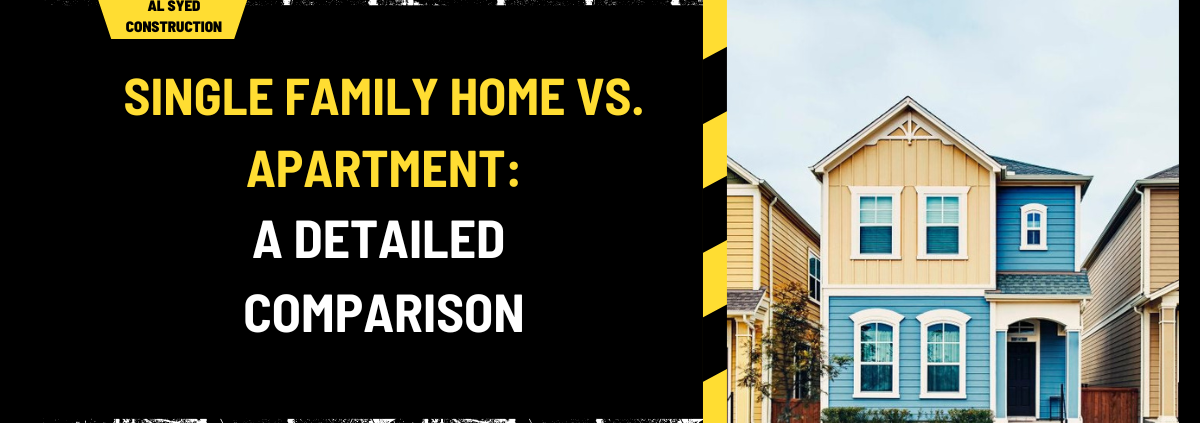Single Family Home vs. Apartment: A Detailed Comparison
When deciding between a single-family home and an apartment, it’s essential to consider various factors including lifestyle, budget, and personal preferences. This comprehensive guide explores the key differences between these two housing options, helping you make an informed decision based on your specific needs.
Advantages of Single Family Homes
**1. Space and Privacy
Single-family homes offer substantial benefits in terms of space and privacy:
- Larger Living Areas: Typically, single-family homes provide more square footage compared to apartments, including expansive living rooms, multiple bedrooms, and large yards.
- Private Outdoor Space: Owners often enjoy private backyards, gardens, or patios, perfect for outdoor activities and gatherings.
- Enhanced Privacy: Unlike apartments, where walls may be shared with neighbors, single-family homes ensure complete separation from other residences, reducing noise and ensuring a quieter environment.
**2. Customization and Control
Owning a single-family home grants greater control and customization opportunities:
- Home Renovations: Homeowners can remodel, renovate, and personalize their living spaces without restrictions typically imposed by rental agreements or condo associations.
- Exterior Modifications: Flexibility to alter the exterior, including landscaping and painting, according to personal preferences or aesthetic desires.
**3. Investment Potential
Single-family homes often represent a sound financial investment:
- Appreciation: Properties usually appreciate over time, potentially providing a significant return on investment.
- Equity Building: As you pay down your mortgage, you build equity in the property, which can be advantageous in the long term.
Advantages of Apartments
**1. Affordability and Maintenance
Apartments offer practical benefits in terms of affordability and maintenance:
- Lower Costs: Generally, apartments have lower purchase prices or rental rates compared to single-family homes, making them more accessible for those on a tighter budget.
- Reduced Maintenance: Maintenance responsibilities are typically minimal as the building management handles repairs and upkeep of common areas.
**2. Convenience and Amenities
Apartments often come with several conveniences and amenities:
- Shared Amenities: Many apartment complexes feature amenities such as swimming pools, fitness centers, and communal lounges that may not be available in single-family homes.
- Central Locations: Apartments are frequently located in urban areas with easy access to public transportation, shopping, dining, and entertainment.
**3. Security and Community
Living in an apartment can offer enhanced security and a sense of community:
- Enhanced Security: Apartments often come with security features like controlled access, surveillance cameras, and on-site security personnel.
- Community Feel: Apartment living fosters a sense of community with opportunities for socializing with neighbors through organized events and communal areas.
Comparing Lifestyle Impacts
**1. Family and Lifestyle Needs
Single-family homes and apartments impact family and lifestyle needs differently:
- Single-Family Homes: Ideal for families requiring more space, privacy, and the freedom to modify their home environment. Perfect for those who prefer a quieter, more private living experience with outdoor spaces for children and pets.
- Apartments: Suitable for individuals or couples seeking a more urban lifestyle with access to amenities and minimal maintenance responsibilities. They are often preferred by those who value convenience and proximity to work and social activities.
**2. Long-Term Plans and Flexibility
Single-family homes and apartments offer different levels of flexibility for long-term plans:
- Single-Family Homes: Offer stability and long-term investment potential, which is ideal for those planning to stay in one place for an extended period.
- Apartments: Provide greater flexibility, especially for individuals who may move frequently due to work or personal preferences. Rental agreements typically offer shorter terms compared to the commitment required for homeownership.
Cost Considerations
**1. Initial Costs
Initial costs vary significantly between single-family homes and apartments:
- Single-Family Homes: Require substantial upfront costs including down payments, closing costs, and property taxes. Homeowners are also responsible for ongoing expenses such as insurance, repairs, and landscaping.
- Apartments: Usually entail lower upfront costs with security deposits and application fees. Monthly rental payments may include utilities and maintenance, reducing out-of-pocket expenses.
**2. Monthly Expenses
Monthly expenses are another crucial factor in the comparison:
- Single-Family Homes: Owners pay mortgage payments, property taxes, insurance, and maintenance costs. These expenses can add up but may be offset by the potential for property appreciation.
- Apartments: Rent typically covers some or all utilities, with fewer maintenance responsibilities. However, renters should be aware of potential rent increases or additional fees for amenities.
Final Thoughts
Choosing between a single-family home and an apartment ultimately depends on personal preferences, financial considerations, and lifestyle needs. Single-family homes offer greater space, privacy, and customization opportunities, making them ideal for families and those seeking long-term stability. Apartments, on the other hand, provide affordability, convenience, and access to amenities, catering to those who prefer a more flexible and urban lifestyle.




